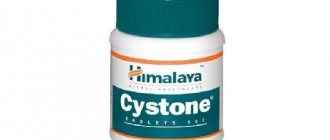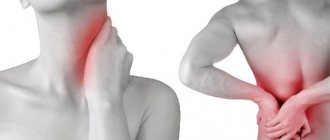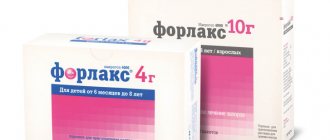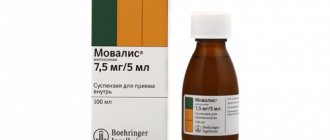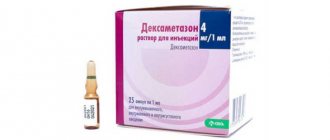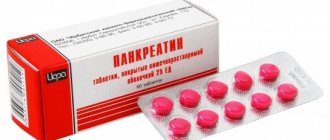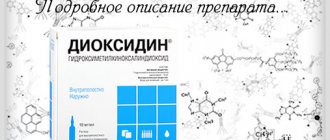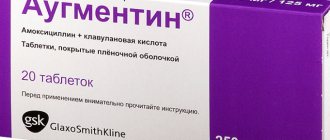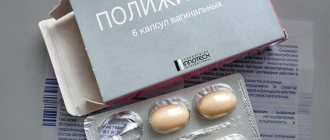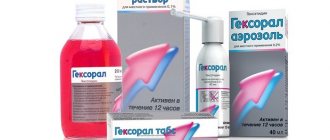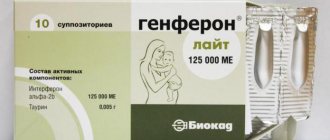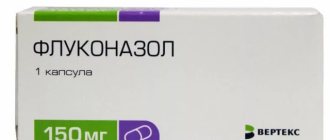Nystatin is an antifungal agent belonging to a number of antibiotics from the polyene group . The main area of application of this drug is the treatment of candidiasis. The active substance used in this product was synthesized more than sixty years ago. Initially, Nystatin was manufactured as an injection solution, but this dosage form had many negative side effects. One of the main disadvantages of this form is the excessive concentration of the active substance, which led to poisoning of the body with toxins.
Today, Nystatin is completely safe for human health. Let's find out what Nystatin tablets help with, and also consider the various nuances associated with this remedy.
Nystatin is an antifungal antibiotic drug
Consideration of release form and chemical composition
Nystatin is manufactured in three dosage forms: suppositories, tablets and ointment for external use. Nystatin tablets have a faint vanilla aroma and are pale yellow in color. Suppositories are made in a cylindrical shape and are used for rectal or intravaginal administration. The ointment has a thick consistency and is available in aluminum tubes of various sizes.
In each of the three dosage forms of the drug, the substance of the same name is used as the active component . Additional components include lactose, specially purified petroleum jelly, magnesium carbonate, talc and starch.
Nystatin
Nystatin is an antifungal antibacterial drug active against yeast-like fungi of the genus Candida.
Release form and composition
- Coated tablets: light yellow with a greenish tint, have a slight smell of vanillin (10 pcs in blister packs; 20 pcs in glass jars; 20 pcs in polymer jars, 1 jar in a cardboard pack) ;
- Ointment: yellow or brownish-yellow (30 g in aluminum tubes);
- Vaginal suppositories: torpedo-shaped, yellow (5 pieces in blister packs, 2 packs in a cardboard pack);
- Rectal suppositories: torpedo-shaped, yellow (5 pieces in blister packs, 2 packs in a cardboard pack).
Active ingredient: nystatin:
- 1 tablet – 250 thousand or 500 thousand units (units of action);
- 1 g ointment – 100 thousand units;
- 1 vaginal suppository – 250 thousand or 500 thousand units;
- 1 rectal suppository – 250 thousand or 500 thousand units.
Excipients:
- Tablets: OPMC, basic magnesium carbonate, calcium stearate, tropeolin O, titanium dioxide pigment, MTs-16, Tween-80, potato starch, vaseline oil, lactose, vanillin;
- Ointment: medical petroleum jelly and anhydrous lanolin;
- Vaginal suppositories: propyl ester of parahydroxybenzoic acid, Witepsol W-35, Witepsol N-15 and food grade citric acid;
- Rectal suppositories: propyl ester of parahydroxybenzoic acid, Witepsol W-35, Witepsol N-15, vaseline oil and food grade citric acid.
For tablets and ointment:
- Therapy of candidiasis of internal organs;
- Treatment of candidiasis of the mucous membranes and skin;
- Prevention of candidiasis during long-term therapy with antimicrobial agents, especially in weakened and depleted patients.
For vaginal suppositories:
- Treatment of vaginal candidiasis;
- Prevention of fungal complications during local antimicrobial therapy.
For rectal suppositories:
- Treatment of candidiasis of the lower intestines;
- Prevention of fungal complications in the pre- and postoperative period.
Terms and conditions of storage
Store in a dry, dark place.
Best before date:
- Tablets – 2 years at a temperature of 18-20 ºС;
- Vaginal suppositories and rectal suppositories – 2 years at temperatures up to 5 ºС.
- Ointment – 3 years at temperatures up to 5 ºС.
Found an error in the text? Select it and press Ctrl + Enter.
Characteristics of the drug
Nystatin is a pharmaceutical agent belonging to the group of antibiotics with a narrow spectrum of therapeutic effects. This drug is used as part of complex therapy for fungal diseases caused by the activity of certain types of pathogenic microorganisms. In addition, the use of the drug makes it possible to suppress the activity of certain forms of intestinal amoeba, which are responsible for diseases such as dysentery.
It is important to clarify that Nystatin is not able to resist the action of viruses and bacteria. Nystatin tablets are almost completely dissolved in the digestive system. The walls of the gastrointestinal tract practically do not absorb the active component. Against this background, the composition of the drug almost does not penetrate into the bloodstream, which avoids negative effects on the body.
The active substance itself is excreted from the body practically unchanged. Despite this nuance, the concentration of nystatin contained in one tablet is sufficient to affect the fungal infection.
Let's find out what Nystatin is used for. The main area of application of the drug is the treatment of the following diseases:
- fungal infections of the oral cavity;
- fungal diseases of the gastrointestinal tract and skin;
- mycosis;
- thrush in women and men.
This medicine can be used for preventive purposes. It is recommended to use the drug to prevent fungal infections in patients with weakened immune systems, patients undergoing long-term treatment with antibacterial medications, as well as people preparing for intestinal surgery.
Nystatin tablets, instructions for use of which will be discussed below, are not recommended for use in the presence of hypersensitivity to the components of the drug. Use of the medicine during pregnancy is allowed only when the result obtained outweighs the risk of the negative effect of the antibiotic on the fetus. During treatment, during lactation, experts recommend switching the child to artificial formula.
It is not recommended to use Nystatin in the presence of diseases such as gastric or duodenal ulcers, liver failure, or inflammatory processes in the pancreas.
Nystatin is used for the treatment and prevention of fungal diseases
Contraindications and possible side effects
Nystatin is a relatively safe drug. But there are a number of conditions in which it is not recommended to use this medicine in the treatment of stomatitis in a child.
Contraindications to the use of antifungal agents:
- individual intolerance to nystatin or auxiliary components of the medication;
- pancreatitis;
- stomach ulcer;
- impaired liver function;
- bacterial, viral type of stomatitis;
- duodenal dysfunction.
Nystatin is tolerated normally by most children. But in the instructions, the manufacturer warns that the drug can cause a number of side effects. Therefore, before using this remedy, you need to familiarize yourself with the list of conditions that may occur during therapy.
When using Nystatin, the following adverse reactions are possible:
- nausea;
- intestinal disorder;
- addition of superinfection;
- vomit;
- allergies in the form of itching, rashes, hyperemia and swelling of the mucous membrane;
- loss of appetite;
- fever;
- abdominal muscle spasms.
Overdose increases the likelihood of side effects. Therefore, it is important to use Nystatin according to the instructions.
How is nystatin used in pharmacology?
Based on Nystatin, a potent antibacterial drug is produced, where tetracycline is used as an additional active component. This combination drug has a relatively low cost (in the Russian Federation, the price varies from seventy to seventy-five rubles). The combination of two potent components allows the medicine to be used not only in the treatment of various diseases, but also for preventive purposes.
The main range of application of this antibiotic is the treatment of diseases where the causative agent of the disease is highly sensitive to tetracycline drugs. The combined drug is used in the treatment of sore throat, bronchitis, intestinal infection, conjunctivitis, sexually transmitted diseases and eczema.
The medicine can be used to prevent infectious diseases. Despite many positive qualities, this combination has strict contraindications. This product is not recommended for use during pregnancy and lactation, as well as in the treatment of diseases in children under eight years of age. Experts do not recommend using this antibiotic in the presence of hypersensitivity to the composition, leukopenia, or liver dysfunction.
Tetracycline, used as an additional active component, has a negative effect on the functioning of the gastrointestinal tract and can provoke allergic manifestations. During a long course of treatment, the patient's sensitivity to ultraviolet rays increases significantly.
Suppositories are made based on nystatin, and Polygynax is used for intravaginal administration. In addition to the antibiotic, the medication contains components such as polymyxin B and neomycin. The combination of the above ingredients gives the drug antibacterial, disinfectant and antimycotic effects.
How does it work and how to use nystatin
The drug contains the active ingredient of the same name - nystatin. It belongs to natural antibiotics and is synthesized naturally by actinomycetes.
"Nystatin" is effective only against fungi of the genus Candida. It interacts with elements of the cell wall of microorganisms, forming “gaps”. This leads to an imbalance between the flow of nutrients and water into the cell and the release of metabolic products. As a result, the nutrition of candida is disrupted and their reproduction is inhibited. Thus, “Nystatin” has a fungistatic effect - it suppresses further division of fungi, but does not cause their death. After a short life cycle, candida die
Therefore, during treatment, it is important to follow the prescribed regimen so as not to provoke a relapse of the disease by activating forms that have not yet died
The main advantages of the drug are as follows:
- resistance develops slowly - the drug in the area of application (for example, in the vagina when using suppositories) creates high concentrations of the active substance;
- well tolerated - “Nystatin” is insoluble in water, so it is quite difficult to penetrate into the systemic bloodstream when taken orally, and even more so when used topically;
- can be used in all groups of people - given the minimal side effects, the drug is recommended for the treatment even of the elderly, pregnant women and children.
Instructions for use
Before talking about how to take Nystatin tablets for thrush, it is important to recall that this remedy belongs to the group of potent antibiotics. This feature of the drug suggests that Nystatin should be used only after being prescribed by a specialist.
The regimen for taking pills, the duration of the course of treatment and the dosage of the drug are prescribed by a specialist based on the nature of the disease, the individual characteristics of the body and other important nuances.
Nystatin is used to prevent the development of candidiasis.
When taking tablets orally, they should not be chewed. The average daily dose for an adult is from two hundred fifty to five hundred milligrams. The tablets should be taken two to four times a day, depending on the severity of the disease. The average duration of therapy varies from seven to fourteen days. In chronic forms of the disease, the patient must undergo two cycles of therapy with an interval of several weeks.
Nystatin tablets instructions for use for oral thrush
When treating fungal infections of the oral cavity, the tablet should be dissolved in the mouth and not swallowed. The drug should be taken half an hour after eating. Many experts recommend rinsing your mouth with chlorhexidine, baking soda, or chamomile-based decoction beforehand.
For similar diseases in children, it is necessary to use the following remedy. The tablets are crushed into powder and then mixed with the contents of one ampoule of vitamin B12. The resulting product is used to treat lesions in the oral cavity. The dosage of the drug is selected based on the age of the child. That is why, before using the medicine, you should consult a specialist.
It is very important when treating fungal infections of the oral cavity to keep the tablets in the mouth for as long as possible. Experts recommend holding the drug until it is completely dissolved. You can prepare a solution based on the tablets. The main advantage of the solution is the ability to improve its taste with the help of sucrose.
In the treatment of oral thrush, you can use not only tablets, but also ointment. For this purpose, a “sandwich application” is made on the basis of the ointment. To prepare the product, you will need two cotton pads, between which the ointment is applied. The resulting “sandwich” should be placed behind the cheek and wait until the composition is completely dissolved. Applications should be used at least five times a day.
Regular use of the ointment will improve your health in just a few days. Using this method allows you to remove plaque and speed up the healing of deep wounds. The ointment should be used until the symptoms of the disease disappear completely.
Instructions for use for genital thrush
In this situation, suppositories are used to treat thrush. Suppositories are used for both rectal and intravaginal administration. Before starting the injection procedure, it is recommended to prepare in advance. For pre-treatment, a solution of Furacilin is used, which is administered using an enema.
The use of suppositories during pregnancy is not recommended. In such a situation, women are prescribed a cream that is used to treat the affected areas of the body. The composition should be used for topical application several times a day. The average duration of treatment is two weeks.
Important! The composition of the drug does not have any effect on the functioning of the central nervous system. Based on this, we can say that while taking the drug you can drive a car and carry out other activities that require increased concentration.
The use of Nystatin is especially important for the prevention of candidiasis that develops with long-term use of tetracycline antibiotics
About the medication in the context of stomatitis treatment
Fungal stomatitis (candidiasis or thrush) is observed in both adults and children, as well as in newborns. Even small doses of Nystatin can slow down the further development of thrush, and systematic therapy should completely destroy the fungus.
To treat stomatitis, nystatin ointment is actively used, which destroys the permeability of fungal cells, so the main bacterial components are destroyed.
Due to the fact that Nystatin neutralizes fungal infections, it is recommended only for candidal stomatitis of the oral cavity.
The molecule of the active component of the drug consists of double bonds, which causes the penetration of the active element into the cells of the fungus. Then the electrolytic process intensifies, causing the fungal cell to be destroyed. There is virtually no resistance or resistance.
In addition to the fact that the medication is used in the treatment of candidal stomatitis, it is also effective as a preventive measure for this disease.
For preventive purposes, Nystatin is effective in preventing the development of
candidiasis
in cases where fairly long-term treatment with drugs such as Penicillin, tetracycline antibiotics, Neomycin, Levomycetin and others is expected.
Nuances associated with use
The medication can be used even during the menstrual cycle. However, it is important to note that both partners should undergo treatment. In order to prevent relapse of the disease, you should abstain from sexual intercourse during the course of treatment. The product, available in the form of an ointment, should be used only for application to the skin. It is not recommended to apply the composition to the mucous membrane of the mouth and nose.
It is also not recommended to use the drug in the presence of viral and staphylococcal diseases. When prescribing treatment with Nystatin, you should notify the doctor about other medications that are used. Some drugs in combination with medication can cause negative reactions in the body.
When to use
The only indication for the use of Nystatin is fungal infection of the skin and mucous membranes. A complete list of pathologies is presented in the table.
Table - When is Nystatin prescribed?
| Sanitation of the vagina and external genitalia | Sanitation of the gastrointestinal tract | Skin diseases |
| — Acute candidiasis; - prevention of exacerbations in the chronic form; - prevention of thrush when taking medications; - candidiasis of the genital organs in men | — Oral candidiasis, for example, stomatitis, gingivitis, glossitis, fungal tonsillitis; — prevention of dysbacteriosis while taking antibiotics, cytostatics, hormonal drugs; — prevention of flora disturbances in the pre- and postoperative period | Skin candidiasis primary and secondary |
It is possible to prescribe Nystatin for pityriasis rosea, psoriasis, and dandruff. However, it is better to carry out unconventional treatment together with a specialist. Depending on the disease, a specific dosage form or even a combination of several is used for greater effectiveness. For example, for genital candidiasis, it is recommended to combine treatment with nystatin ointment and suppositories at the same time.
In case of candidal damage to internal organs (for example, cystitis, pyelonephritis), preference should be given to drugs with greater systemic adsorption. In order to create the necessary con, it requires long-term and high-dose use.
Side effects
This drug is well tolerated by many patients. The annotation for Nystatin states that the composition has side effects. Side effects of Nystatin appear as:
- Disorders of the digestive system.
- Loss of appetite, attacks of nausea and vomiting.
- Allergies, expressed in the form of hives, itching, redness of the skin surface and the appearance of a rash.
If the above symptoms appear, the course of treatment should be stopped completely. In some cases, patients may need symptomatic therapy.
special instructions
When taking Nystatin, possible drug interactions should be taken into account. The main caveats are as follows:
- “Clotrimazole - the activity of “Clotrimazole” decreases;
- "Polymyxin", "Nifurotel" - increase the effectiveness of "Nystatin";
- antacid medications - reduce the effect of Nystatin;
- penicillins, cephalosporins - reduce their bactericidal effect when combined with Nystatin;
- oral contraceptives - breakthrough bleeding and spotting are possible when combining Nystatin with them.
The use of Nystatin for thrush is completely justified and is an effective treatment. But the drug should be prescribed only by a doctor, preferably taking into account bacteriological culture (vagina, intestines) for sensitivity. After the first use, the medicine helps get rid of itching, burning, and reduces discharge.
Cost of the drug and shelf life
The time has come to move on to the main question, how much do Nystatin tablets and other forms of the drug cost? This medicine belongs to medications included in list B. This means that the medicine should be stored at a certain temperature and humidity. All necessary recommendations are contained in the instructions for use.
The price of Nystatin tablets in pharmacies in Russia varies from forty to one hundred and thirty rubles. The average cost of a tube of ointment is about sixty rubles. The price of candles ranges from fifty to seventy rubles.
The active ingredient was first isolated in 1950
When is Nystatin prescribed?
Nystatin is used only for proven candidiasis infection, when, according to the results of a bacteriological study, the pathogen responds to the drug. Each form of release has its own indications for use.
| Form of the drug | Indications for use |
| Ointment Pills | Damage to the skin: smooth skin, folds, nails and hair follicles Fungal infection of the mucous membranes: mouth, glans penis and foreskin, vulva Disease of internal organs: general and isolated candidiasis of the digestive, respiratory, nervous and other systems For prophylactic purposes during long-term treatment with antibiotics, especially in severe and debilitated patients |
| Vaginal suppositories | Candidiasis of the vagina (thrush) Prevention of the development of fungal infection against the background of local antibacterial therapy |
| Rectal suppositories | Fungal disease of the rectal mucosa Before and after intestinal surgery to prevent candidiasis |
Highly effective in acute forms of candidiasis infection. If the process is chronic, in most cases the fungus is not sensitive to the drug.
Analogs
Nistitin analogues are divided into two categories: similar in composition and similar in therapeutic effects. Below is a list of the most effective drugs belonging to these groups.
- Mycostatin is a structural analogue of Nystatin tablets. The drug is used in the treatment of fungal diseases in young children. The key feature of Mycostatin is the minimum number of side effects.
- Anticandin is another antibiotic that uses nystatin as an active component. The release form of the drug is completely identical to Nystatin.
- Levorin - has a similar therapeutic effect. The drug is used in the treatment of various fungal diseases, as an independent remedy.
The above medications should be used only after consultation with a specialist. Each medicine has its own characteristics, side effects and contraindications.
Nystatin tablets - composition and analogues
The product, which includes the antifungal antibiotic nystatin, is prescribed as a treatment for candidiasis of the vagina, gastrointestinal tract and mucous membranes of the skin, as well as for the prevention of fungal infections during long-term use of antibiotics or before surgery.
In addition to the antibiotic, Nystatin uses excipients such as lactose, magnesium carbonate, potato starch, and petroleum jelly. Therefore, tablet therapy is not recommended for people with lactose intolerance. It is impossible to name structural analogues of the drug, but they have a similar antifungal effect:
- Anticandin;
- Mycostatin;
- Fungicidin.
Price for Nystatin ointment
The product is sold at the pharmacy with a prescription. You can order and buy inexpensively in the online store; the catalog offers medicine in any form and dose. The cost in Moscow pharmacies does not differ too significantly. Price for Nystatin ointment, price comparison table:
| Price | Price in rubles | |
| tube 15 g | tube 30 g | |
| Minimum | 30.00 | 68.00 |
| Average | 72.00 | 82.00 |
| In online stores | 42.00 | 65.00 |
Important recommendations when treating candidiasis
When treating thrush with Nystatin, you must adhere to the following basic rules:
- Women are not recommended to use vaginal suppositories during their periods.
- You cannot drink alcohol at the same time.
- Limit the consumption of fried, smoked and salted foods.
- It is not recommended to take Clotrimazole at the same time, as the effect of treatment will decrease.
- Both partners must undergo treatment.
- It is better to abstain from sexual relations during the period of therapy.
- Carry out a repeat therapeutic course after 14-20 days.
Treatment of candidiasis in the early stages in a woman can be carried out using suppositories and ointment with nystatin
Treatment of thrush with Nystatin in women and men allows you to achieve the desired effect in a fairly short time. The drug has an effect on fungal infection at any stage of the disease. But you should remember that you should not choose medications for treatment on your own, as this can lead to undesirable health consequences.
Reviews: “I’ve been “divorced” from thrush for 7 years”
Low price, affordable and effective drug that really helped. I have been using it for 2 years, after expensive medications that did not help at all, this is the only remedy that has proven itself. I used it according to the instructions, no more than 7-10 days, and also for prevention against thrush. After several uses, I forgot what thrush was, I immediately felt comfort and the discomfort disappeared as if by hand.
Julia K., https://protabletky.ru/nystatin/#otzivi
Nystatin ointment is almost always in my medicine cabinet. It is known that nystatin tablets can only be purchased with a prescription, but ointment can be purchased without any problems. I usually use it for thrush, externally. Women know that when the immune system is weakened, thrush often manifests itself - after all, fungi are always present in the body in small quantities, and when the immune system is weakened, they can begin to multiply aggressively. The texture of nystatin ointment is a little greasy, it is better to use a pad, but the ointment instantly soothes and softens the mucous membranes.
Unnamed, https://www.piluli.ru/product/Nistatin/review
I was sick for a month with a severe flu and as soon as I got out of it, a drug-induced thrush started after antibiotics. I bought Nystatin in suppositories, it really helps quickly, after the first suppository I felt relief, but the suppositories are very unpleasantly greasy, I put a pad on at night so as not to stain my underwear.
Alena, https://www.piluli.ru/product/Nistatin/review
For a long time I suffered from chronic thrush. Expensive drugs gave short-term results. Until the doctor suggested how to use nystatin topically. After douching with soda, wash off the shell of the nystatin tablet and place it deeper in the vagina at night. And for prevention, tampons moistened with an aqueous solution of propolis help well.
Irina, https://www.tiensmed.ru/news/nistatinnus1.html
Nystatin is currently the best drug. For a long time I was treated for thrush with all modern drugs that were only advertised on TV. I spent a lot of money, but the thrush did not go away. I went to the clinic and not just any time. I took tests and was given a transcript of the antibiogram for the analysis, i.e. which drug reacts correctly to my candida (thrush) and was very surprised that all the modern drugs listed on the list did not show a positive result. And the result was only nystatin. So think for yourself that the outdated drug that was used during the Second World War did not turn out to be the best solution to the problem! yes, it’s inconvenient that you have to drink it for ten days, but damn, after all these unpleasant sensations that I experienced while living with thrush... it was worth it and what does the antibiotic itself cost a penny compared to everyone else. So don’t be fooled by advertising and a quick solution in three days, and by the way, I’ll probably sign up, I’ve been divorced from a thrush for 7 years))) be healthy!
Regina, https://www.tiensmed.ru/news/nistatinnus1.html
Stomatitis and candidiasis
Nystatin for stomatitis in a child is prescribed only by a doctor if there are appropriate indications. These include the appearance of characteristic white spots, which are very painful. In this case, newborns experience loss of appetite, tearfulness, nervousness when feeding, and sleep disturbances. Nystatin for stomatitis in children is applied only to areas of the mucous membrane affected by the fungus. Treatment of the oral cavity against stomatitis is carried out no more than twice a day. With more frequent use of the drug, it can cause discomfort in the mouth, swelling, and allergic reactions.
Nystatin for oral thrush in infants is used in the form of an aqueous solution. To make it, take 1 tablet and grind it thoroughly in a mortar. Then dilute with an oil solution of vitamin B 12 and mix thoroughly. The drug diluted in this way is used to treat the child’s mouth. If you don’t have a vitamin on hand, then this drug is diluted with warm water. If necessary, you can let the mixture sit for a couple of minutes, then move it again and use it for its intended purpose. This replacement will not reduce the effect of the resulting suspension.
Nystatin for thrush for infants can also be prescribed in tablet form. Before taking Nystatin in this form for the treatment of thrush in infants, you need to crush one tablet and take a quarter. Or simply divide into four parts and give a quarter of the tablet. After taking the medicine, the baby is not fed for 30 minutes. It is forbidden to even give water during this period of time, so treatment is best done not before breastfeeding, but after it.
Using drops to treat thrush in the mouth involves treating the mucous membranes with a bandage or gauze moistened with a few drops of the medicine. The course of therapy should not exceed 1.5 weeks.
For older children, this medicine is prescribed in tablet form. Only the pediatrician calculates the dosage. The drug is absorbed behind the cheek and thus the active substances with saliva are evenly distributed throughout the oral mucosa. This creates a protective film. Therefore, it is necessary not to eat or drink for at least half an hour after dissolving the tablet. Is it possible to use ointment? It is indicated for older children. It is used to treat affected areas of the skin and mucous membranes. The medicine can quickly relieve all clinical manifestations of the disease and destroy the disease.
Nystatin for children
According to the instructions, the child is given the drug in a reduced dosage. Doctors try not to prescribe nystatin to children if the lining of the oral cavity is affected by fungus, because Buccal administration of tablets may be difficult. To treat this type of candidiasis, some doctors recommend grinding a tablet with a concentration of 250,000 units, and then mixing the resulting powder with 1 ml of vitamin B. The solution should be used to treat damaged areas of the mucous membrane. The instructions for use indicate the following doses of antibiotic for children:
- from 6 months to 1 year – 125,000 units 2 times/day;
- from 1 to 3 years – 250,000 units 3 times/day;
- from 3 to 13 years – 400,000 units 3-4 times/day;
- over 13 years old – 500,000 units 4 times a day.
When not to use
The drug is contraindicated:
- with impaired liver function;
- if the child is diagnosed with pancreatitis;
- for gastric ulcers;
- in the presence of an ulcer in the intestines, namely in the duodenum;
- in the presence of intolerance to the components of the drug.
According to the instructions for use, the medicine is not prescribed to children under one year of age. However, doctors use this remedy for the treatment of severe mycoses in infants. The use of this medicine for a newborn should be strictly under the supervision of a pediatrician.
Ointment or cream
Nystatin ointment is widely used in the complex treatment of thrush. Doctors recommend starting to use ointment (cream) at the first symptoms of fungal pathology. Women need to use nystatin suppositories at the same time, and men need to use tablets. To achieve greater effectiveness, nystatin ointment must be used in conjunction with tablets or suppositories.
Nystatin ointment for thrush should be applied to the mucous membrane of the vagina or penis in a thin layer two or three times a day. As a rule, the course of such therapy is no more than two weeks. Further, it is possible to use the ointment for preventive purposes once a day. Before using the ointment, you should also perform hygiene of the external genitalia.
Important! Nystatin ointment for chronic thrush should be used only with tablet medications or suppositories. Otherwise, the treatment will be ineffective.
The drug "Fluconazole"
This analogue of “Nystatin” in tablets is used to treat ailments caused by fungi. This agent, having a highly specific effect, inhibits the activity of enzymes of pathogenic microorganisms. The active substance of the drug prevents the process of conversion of lanosterol into elgosterol in fungal cells, as a result of which the permeability of membranes increases and the death of pathogenic microorganisms occurs.
The medicine is available in three main forms: tablets, solution for infusion, capsules. The doctor decides in what form to use the drug depending on the location of the disease.
Contraindications
If a doctor has prescribed Nystatin, there is no point in looking for cheaper analogues. After all, this domestically produced medicine is the most affordable. However, it has a list of contraindications that you should pay attention to before use. Thus, people suffering from pancreatitis, peptic ulcer of the duodenum and stomach should avoid taking the drug. You should not use the medication if you have various liver dysfunctions or hypersensitivity to any of the components of the medication. During pregnancy and for the treatment of candidiasis in children under one year old, it will also be necessary to replace Nystatin. Analogues in all the above cases should be selected exclusively by a doctor.
Doses and duration of use
The treatment regimen given is average data, and not instructions for using the medicine. The dosage regimen and timing of treatment are determined only by the attending physician, based on the course of the disease in a particular patient.
| Localization of candida infection | Form of the drug | Nystatin dose and how to use | How many times a day to use | Course duration in days |
| Internal organs (lungs, kidneys, liver, heart, brain) | Pills | 500,000–1,000,000 units Take orally Regardless of food | 4–8 | 10–21 |
| Oral cavity | Pills | 500,000 units Rinse your mouth Dissolve the tablet in your mouth Do not eat or drink for 30–60 minutes | 4–8 | 10–15 |
| Intestines | Pills | 250,000–500,000 units Take without chewing Between meals | 4–6 | 10–21 |
| Leather Mucous membranes | Ointment | 3–5 g Wash affected area with soap and water Apply a thin layer Do not wash off for an hour | 2 | 7–14 |
| Vagina | Vaginal suppositories | 250,000-500,000 units Carry out hygienic treatment of the genitals Lying on your back, insert the suppository to the depth of one finger into the vagina or rectum Don't get up for one hour | 2 | 10–14 |
| Rectum | Rectal suppositories |
According to indications, the course of therapy can be repeated one week after the end of the previous one.
When treating urogenital and cutaneous candidiasis, the vaginal and ointment forms of Nystatin can be combined with tablet forms to enhance the effectiveness of therapy.
Synonyms of nosological groups
| Category ICD-10 | Synonyms of diseases according to ICD-10 |
| B37 Candidiasis | Visceral candidiasis |
| Invasive candidiasis | |
| Laryngeal candidiasis | |
| Candidiasis of the gastrointestinal tract | |
| Candidiasis of the skin and mucous membranes | |
| Candidiasis of mucous membranes and skin | |
| Candidiasis of the mucous membranes | |
| Candidiasis due to Candida albicans | |
| Candidomycosis | |
| Acute pseudomembranous candidiasis | |
| Chronic forms of candidiasis | |
| B37.2 Candidiasis of the skin and nails | Fungal paronychia |
| Fungal eczema | |
| Fungal dermatoses | |
| Fungal diseases of smooth skin | |
| Fungal infections of smooth skin | |
| Fungal infections of smooth body skin | |
| Fungal nail infections | |
| Yeast skin infection | |
| Skin candidiasis | |
| Candidiasis of the skin and mucous membranes of the mouth and pharynx | |
| Candidiasis of the skin of the nail folds | |
| Candidiasis of the nail folds | |
| Nail candidiasis | |
| Candidiasis with damage to the skin and mucous membranes | |
| Candidiasis of mucous membranes and skin | |
| Candidal paronychia | |
| Candidomycosis of the skin | |
| Skin candida infections | |
| Cutaneous candidiasis | |
| Interdigital fungal erosion | |
| Mycotic dermatitis | |
| Paronychia candidiasis | |
| Superficial form of skin candidiasis | |
| Superficial candidiasis | |
| Superficial nail candidiasis | |
| Superficial mycosis of the skin | |
| Chronic skin candidiasis | |
| B37.3 Candidiasis of the vulva and vagina (N77.1*) | Vaginal candidiasis |
| Vaginal candidiasis | |
| Vulval candidiasis | |
| Vulvovaginal candidiasis | |
| Vulvovaginal candidiasis | |
| Vulvovaginitis candidiasis | |
| Vulvovaginitis mycotic | |
| Fungal vaginitis | |
| Vaginal candidiasis | |
| Candidiasis of internal organs | |
| Genitourinary candidiasis | |
| Candidiasis of the genitourinary organs in women | |
| Candidiasis with damage to the skin and mucous membranes | |
| Candidiasis of the mucous membranes | |
| Candidiasis of mucous membranes and skin | |
| Candidal vaginitis | |
| Candidiasis vulvitis | |
| Vulvovaginal candidiasis | |
| Colpitis of fungal etiology | |
| Vaginal thrush | |
| Moniliasis vulvovaginitis | |
| Acute vaginal candidiasis | |
| Acute mycosis of the vagina | |
| Superficial candidiasis of the genital mucosa | |
| Recurrent vaginal candidiasis | |
| Recurrent vaginal candidiasis | |
| Urogenital candidiasis | |
| Chronic vaginal candidiasis | |
| Chronic candidiasis of the mucous membranes | |
| Chronic recurrent vaginal candidiasis | |
| B37.4 Candidiasis of other urogenital sites | Genital candidiasis |
| Genitourinary candidiasis | |
| Candidiasis of the mucous membranes | |
| Candidal balanitis | |
| Candidiasis balanoposthitis | |
| Candiduria | |
| Superficial candidiasis of the genital mucosa | |
| Urogenital candidiasis | |
| B37.8 Candidiasis of other sites | Fungal diseases of the larynx |
| Fungal infections of the conjunctiva | |
| Fungal infections of the cornea | |
| Disseminated candidiasis | |
| Candidiasis of internal organs | |
| Intestinal candidiasis | |
| Perianal candidiasis | |
| Candidiasis of the esophagus | |
| Candidiasis of the rectum and lower intestine | |
| Candidiasis of the mucous membranes of the esophagus | |
| Candidomycosis of mucous membranes | |
| Mycotic jam | |
| Mycotic eczema | |
| Mycotic dermatitis | |
| Non-invasive intestinal candidiasis | |
| Chronic candidiasis of the mucous membranes | |
| Esophageal candidiasis |
Thrush (or candidiasis) is an infectious disease of a fungal nature that develops against the background of intensive growth of colonies of opportunistic yeast fungi of the genus Candida.
It can be transmitted sexually, through particularly close contact, or occur independently.
Until now, experts cannot establish the exact cause of the appearance of this disease in some people and the lack of tendency to develop it in others.
It is believed that the growth of candida fungi occurs due to changes in the level of hormones in the human body that affect the environment of the mucous membrane of the genital organs. If symptoms of the disease appear, you should immediately consult a doctor. Need to pay attention:
- for the presence of a whitish, cheesy coating on the mucous membranes;
- white discharge from the genital tract with a sour smell;
- for itching and burning in the genital area.
Don't be afraid. First of all, it is not a sexually transmitted disease. Secondly, modern medicine has a wide range of pharmaceuticals that can cure this disease. Of course, only an integrated approach in accordance with all the doctor’s recommendations will help cope with the disease.
It should be noted that not only adults suffer from this pathology. Very often, thrush is detected in newborns and infants. It can affect both the child’s genitals and the oral cavity.
With genital candidiasis, the symptoms will be the same as in adults.
When the oral cavity is affected, a white cheesy coating is noted on the surface of the tongue, gums and cheeks, which has a sour odor and is easily removed with a gauze swab.
Nystatin is a long-known drug that has been considered an effective remedy in the fight against thrush since the days of the USSR.
The medicine belongs to the category of antifungal agents that are active against yeast-like fungi of the genus Candida.
Nystatin molecules are able to integrate into the membrane of their cells, forming channels through which the uncontrolled release of nutrients to the outside occurs. As a result, the fungi begin to die.
The resistance and addiction of microorganisms to Nystatin develops very slowly.
This remedy is equally effective in the treatment of thrush in both women and men and children.
It is often used to destroy growing candida colonies, as well as to prevent the onset of the disease during long-term use of broad-spectrum antibiotics.
However, Nystatin does not show activity against pathogenic viruses, bacteria and actinomycetes.
Nystatin, discovered back in 1950 in the USA by pharmaceutical chemists Rachel Brown and Elizabeth Hazen, was initially used as an injection to treat internal and external infections of the skin, vaginal mucosa and esophagus. However, the toxicity of the substance was subsequently proven when it reaches a certain level in the blood. That is why doctors abandoned further intravenous and intramuscular use of the drug.
Experimental studies and facts about the use of this medicine have proven that oral (internal) and topical (external) use is absolutely safe, since there is minimal release of the active substance into the blood. At the same time, the drug practically does not interact with other medications.
Nystatin is highly effective in the treatment of candidiasis of various organs and tissues. Most often, the drug is used to prevent fungal diseases in people at high risk of occurrence or infection. Among them:
- HIV patients;
- undergoing chemotherapy;
- operating patients;
- premature babies with birth weight less than 1500 grams;
- people suffering from metabolic disorders (hypothyroidism, diabetes, high obesity).
The active substance of the drug is nystatin (named after the laboratory in New York State where the drug was discovered).
There are several forms of release of Nystatin:
- ointment for external use;
- rectal suppositories;
- vaginal suppositories;
- film-coated tablets;
- substance-powder.
In addition to the active substance, each pharmaceutical type of drug contains additional/auxiliary components.
Features of therapy
- If the course of treatment coincides with menstruation, then do not cancel suppositories with Nystatin for thrush - the effect of the medicine will remain.
- Refrain from sexual intercourse during the period of treatment of urogenital candidiasis.
- Carry out preventive treatment of the sexual partner if thrush is diagnosed.
- When treating with more than one antifungal drug, take into account that Nystatin reduces the effectiveness of Clotrimazole.
Treating the symptoms of thrush with suppositories is a reliable and proven way to combat this pathology. However, you can cure rectal or vaginal thrush only if you know how to properly administer suppositories.
Rectal
In order for suppositories with Nystatin to be beneficial and easier to use, it is necessary to maintain the correct storage temperature - in the refrigerator (not higher than 5°C). Suppositories are much easier to administer if they are cool. The dosage form can be administered while standing or lying on your side.
Algorithm of actions when introducing suppositories:
- Take a shower and wash your hands thoroughly before handling. You can treat them separately with a disinfectant. It would also be good to cool them a little - hold them under running cold water or pick up an ice pack (this will help the candle melt more slowly during the procedure).
- The patient should take a comfortable position, and then open 1 suppository. As a rule, at the base of the “torpedo” you need to pull the solder in different directions or you can use scissors.
- All movements must be performed quickly so that the medicine does not leak in your hands. It is necessary to spread the buttocks and insert the candle (sharp end) to the depth of the index finger. After this, the sphincter must be squeezed and lie there for several minutes.
- Before inserting the suppository, to facilitate the process. You can lubricate the anus with Vaseline, fatty oil or baby cream. It is important to avoid sudden movements so as not to damage the mucous membrane in the rectum during the insertion process.
- After administering the suppository, it is advisable to lie down for 30-40 minutes and refrain from bowel movements during this time. I will have the urge to go to the toilet - this is a normal physiological phenomenon. But you need to overcome yourself so that the medicine has time to be absorbed and begin to act.
If the candle is placed overnight, the substances that form the basis of the dosage form are almost completely absorbed. But if this is a morning application and after half an hour you need to return to your usual routine, then the foundation may begin to leak. This will not affect the treatment, since during this time the medicine itself has already managed to be absorbed and begins to act.
The base of rectal suppositories usually contains liquid or white soft paraffin, petroleum jelly, animal fat or something else. Once in the rectum at a temperature of 36.6 - 37.0 °C, they begin to melt and gradually leak. To avoid discomfort during treatment, you must use daily sanitary pads.
Vaginal
Vaginal suppositories are produced using the same technology as rectal suppositories. Only some components of the base can distinguish them, but their storage conditions are usually the same - in the refrigerator.
Some intravaginal suppositories are administered after soaking with water, while others have special applicators. However, most vaginal suppositories, including Nystatin suppositories, are inserted without additional devices using the index finger. Many women find it more convenient to do this lying down, pulling their knees to their chest, and some manage to do it standing or slightly crouching.
Nystatin suppositories are administered twice a day - in the morning and before bedtime. After showering and douching with warm water without soap, 1 suppository is inserted with clean hands deep into the female genital tract. For hygienic reasons and to reduce discomfort, a woman should use panty liners throughout the entire therapeutic course.
Doctors recommend abstaining from sexual intercourse throughout the entire therapeutic course. This will protect against re-infection.
Quite often, representatives of the stronger sex do not show symptoms of the disease, but they remain carriers and infect their sexual partners. If one of the partners has symptoms of candidiasis, both should be tested and treated.
Pharmacological properties
To understand how to treat thrush with Nystatin, you need to have a good understanding of what kind of drug it is. The medicine is an antifungal. It has the same active ingredient - nystatin, which belongs to the pharmacological group of polyene antibiotics. This chemical compound exhibits high activity against yeast-like candida fungi.
When mushrooms come into contact with the main component of Nystatin, the permeability of their cell membrane is disrupted, and the main components of the cell come out. The drug inhibits the reproduction and growth of pathogenic fungi, and in large doses causes the death of fungal cells.
After taking the tablet, the active substance is poorly absorbed from the digestive tract. When applied topically or rectally/vaginally, it does not enter the bloodstream and therefore does not have a systemic effect on the body. With repeated use in therapeutic dosages, its effect does not increase (there is no cumulative effect). Nystatin leaves the body with excrement.
Nystatin - contraindications
The official manufacturer in the instructions for the drug indicates the following contraindications of Nystatin for women: pregnancy (especially the first trimester), breastfeeding. For all patients, the list is as follows: allergic reaction to the drug, peptic ulcer, pancreatitis, liver disease (chronic severe form). Antifungal ointment has side effects (an allergic reaction) and poor compatibility with some other medications (for example, clotrimazole).
Means "Diflucan"
This antifungal agent is used both for mycoses of the skin and mucous membranes, and for candidiasis of internal organs. Fluconazole is used as the main active ingredient. The product is currently available in capsules, in the form of a powder for self-preparation of a suspension, and in the form of a solution for injection. This allows you to choose the most appropriate method of using the medicine to achieve the best therapeutic effect, depending on the nature and complexity of the disease.
The advantage of the product is that its use has no age restrictions and can be prescribed even to babies from birth. The drug also has an impressive list of adverse reactions, so patient reviews about it are not always positive. But in most cases, people are satisfied with the results of treatment.
Analogues of the drug
Modern pharmacology offers an incredibly extensive list of all kinds of drugs for thrush in a variety of forms. Pharmacies offer many options for combination treatment with drugs of the same name, since almost every name contains not only tablets or capsules for internal use, but also ointments, creams, gels, vaginal suppositories, as well as powders for preparing suspensions, syrups and solutions.
Of course, not every remedy is presented in such a wide variety of dosage forms, but almost all, like Nystatin, can be used in the form of tablets, ointments and suppositories.
Some drugs of a number of polyene antibiotics can be called analogues of Nystatin, for example: Natamycin and Levoy.
Several imidazole agents can also be classified as analogues, in particular: Miconazole, Ketoconazole, Clotrimazole.
Some triazoles are also analogues of Nystatin, for example: Itraconazole and Fluconazole.
Interaction of Nystatin with other drugs
Nystatin interacts with few pharmacological drugs, since it practically “transits” through the human body. It is not absorbed or accumulated, does not penetrate through the mucous membranes into the blood, and does not undergo any biotransformation process.
The only exceptions are some drugs with which it can interact and lose its activity or reduce the effectiveness of a particular drug.
Tetracycline with Nystatin - complement each other well, providing a pronounced antimicrobial and antifungal effect; Clotrimazole with Nystatin - reduces the activity of Clotrimazole; Polymyxin and Nifuratel - enhance the effect of Nystatin; antacids with aluminum, calcium, magnesium (Almagel, Maalox, etc.) - reduce the activity Nystatin; indirect anticoagulants (Warfarin, Acenocoumarol, Phenindione, Coumadin, etc.) - their activity decreases under the influence of Nystatin, increasing their dosage is required; bactericidal antibiotics (penicillins, cephalosporins) - their effectiveness decreases when interacting with Nystatin; Chymotrypsin - the effectiveness of Nystatin increases ;estrogen-containing oral contraceptives (Marvelon, Logest, etc.) - their effectiveness under the influence of Nystatin may decrease, and the risk of breakthrough (intermenstrual) bleeding increases; when combining retinol drugs with Nystatin, the risk of increased intracranial pressure increases.
Dosage forms
When taking Tetracycline and Nystatin simultaneously, the therapeutic effect of both drugs is enhanced. It is not recommended to take tablets together with antacids, because this reduces their medicinal properties. The effectiveness of oral contraceptives and indirect anticoagulants under the influence of Nystatin is greatly reduced. The medicine negatively affects other antibiotics, reducing their effect on pathogens.
Diseases that arise from candida fungi are very diverse, which is why the drug is available in various dosage forms. For different types of candidiasis and thrush, Nystatin can be prescribed in one or several of the following forms:
- Vaginal suppositories Nystatin. Visually, suppositories resemble a torpedo. In pharmacies you can buy candles for 250,000 units and 500,000 units. It is used for preventive and therapeutic purposes for candidiasis of the genitals and vagina. And also for preventive purposes against candidomycosis, which occurs during long courses of antibacterial therapy and in patients with weakened immune systems.
- Rectal suppositories Nystatin. They look the same as vaginal suppositories and have an almost identical composition, but they contain petroleum jelly as an auxiliary component. They must be used exclusively for their intended purpose - inserted into the rectum. It is appropriate to treat thrush with Nystatin in rectal suppositories in cases of detection of candidiasis in the rectum, especially in its lower parts.
- Nystatin ointment. This drug is not produced by any pharmaceutical company in the form of a cream or gel. The use of Nystatin ointment for thrush (balanoposthitis) is indicated, as well as for the treatment of stomatitis caused by yeast. In addition, the ointment is used to treat candidiasis in the inguinal folds, inflammation of the buttocks in infants that are of fungal origin, as well as for the prevention of various candidomycosis.
- Nystatin tablets. As a rule, they are always coated and come in 2 dosages: 250 thousand units and 500 thousand units. First of all, the medicine in tablets is used when forms of candidiasis sensitive to nystatin appear, which affects the digestive tract. This often happens after a long course of taking antibiotics or anticancer drugs.
“For chronic candidiasis, complex therapy is indicated, in which, along with tablets, it is also necessary to use other forms of the drug.”
Suppositories
Nystatin suppositories for thrush can be used by women for both chronic and acute forms of fungal pathology. They are an effective remedy because they act directly on the affected areas of the vaginal mucosa. Typically, suppositories are administered twice a day: in the morning and in the evening. The average course duration is 2 weeks.
The effectiveness of the suppository is based on the rapid absorption of the active substance and its prompt effect on the mucous membrane, where the pathogenic fungus is localized and multiplies
Note! The doctor prescribes suppositories based on test results. Typically, suppositories of 500 thousand units are prescribed, but in some cases the dosage can be 250 thousand units.
Before using suppositories with nystatin for thrush, a woman needs to carry out certain preparations. Before administering the suppository, you must wash yourself thoroughly (you can do the douching procedure). This should be done in order to clean the vaginal walls and wash away the discharge. For these hygienic procedures, you can use a decoction of medicinal herbs, a weak solution of potassium permanganate or soda, and furatsilin.
If the fungal infection spreads in the internal organs (in the intestines or esophagus), then rectal nystatin suppositories are used. They are injected into the rectum twice a day (morning and evening). Before the procedure, it is better to take a shower or wash well.
The drug Nystatin
This medicine is used to treat candidiasis caused by the fungus candida albicans. One of the advantages of Nystatin is that pathogenic organisms cannot develop resistance to it. You can take the medicine only as prescribed by your doctor, because it often causes gastrointestinal (GI) side effects.
| Release form | Components | Concentration in action units (ED) |
| Pills | Nystatin | 250000/500000 |
| Lactose, hydroxypropyl methylcellulose, calcium stearate, basic magnesium carbonate, potato starch, titanium dioxide pigment, methylcellulose-16, Tween-80, petroleum jelly, tropeolin O, vanillin | — | |
| Ointment | Nystatin | 100000 per 1 g |
| Medical Vaseline, Anhydrous Lanolin | — | |
| Candles | Nystatin | 250000/500000 |
| Citric acid food grade, pure medical antioxidant, witepsol, butyloxyanisole, dibunol or ionol food grade, medical petroleum jelly | — |
Nystatin is an antifungal antibiotic. It is started to be taken at the first symptoms of thrush. The medicine is effective against fungi of the genus Candida spp and aspergillus. The active substance binds to sterols in the cell membrane of fungi, causing disruption of its permeability and destruction of the main components of the cell. When applied topically, the antibiotic is practically not absorbed. After oral administration, the drug is poorly dissolved in the gastrointestinal tract.
- During pregnancy, a doctor may prescribe Nystatin if the benefits of its use outweigh the potential harm to the fetus;
- During lactation, the drug is contraindicated because it passes into breast milk. A doctor can prescribe Nystatin only in vital cases;
- With an overdose of Nystatin, side effects may increase. Treatment should be symptomatic;
- The drug in the form of 500,000 units is not recommended for use in children under 13 years of age;
- The drug does not affect the nervous system, so it can be used when driving;
- If necessary, you can additionally use suppositories with Nystatin.
It is not recommended to use Nystatin and Clotrimazole at the same time, since the effectiveness of Clotrimazole is reduced.
Video
The video talks about how to quickly cure a cold, flu or acute respiratory viral infection.
Opinion of an experienced doctor. Attention, TODAY only!
If it is necessary to replace the drug, there are two options - choosing another medication with the same active substance or a drug with a similar effect, but a different active substance. Drugs with similar effects are united by the same ATC code.
Nystatin analogues, list of drugs:
- Left,
- Natamycin;
- Ketoconazole,
- Miconazole,
- Clotrimazole;
- Fluconazole,
- Intraconazole.
When choosing a replacement, it is important to understand that the price, instructions for use and reviews of Nystatin do not apply to analogues. Before replacing, you must obtain the approval of your doctor and do not replace the drug yourself.
Cross-drug interactions
If the dosage is observed, it is well tolerated. Side effects are rare:
- Decreased appetite, diarrhea, nausea, vomiting;
- fever, chills;
- skin allergy.
The action of the pharmaceutical drug is aimed at combating the infectious fungus candida and the microorganism aspergillosis. The medication destroys the cell membranes of the infectious agent, which leads to the death of the entire cell. As a result, the pathogenic microorganism dies.
Usually the drug is well tolerated without causing side effects, since it is practically not absorbed by the intestines. In rare cases, taking pills can provoke the following phenomena:
- vomiting and diarrhea;
- skin rash and itching;
- temperature increase.
Less commonly, an antimycotic provokes the proliferation of pathogenic fungal flora, which develops resistance to the medicinal component. In this case, immediate discontinuation of the drug is required.
Nystatin and thrush are two incompatible things. This pharmacological drug fights yeast-like fungi of the genus Candida at a high level. After taking the first tablet, the medicine begins to have an effective effect. The drug forms a dense film, through which the fungus enters the cavity of this trap and quickly dies. It is effective enough that food, liquid and even urine from the vagina cannot damage its integrity.
If Nystatin is used in small quantities, this entails a slowdown in the growth of bacteria, and when a large dosage is used, they are completely destroyed. The drug is so powerful that after the first tablet the death of fungal tumors occurs. Its effectiveness has been proven by reviews of many women who use the product to treat candidiasis.
Reviews
It is important to read the reviews of women who have experienced the effectiveness of the drug on themselves.
Elena, 45 years old. The doctor prescribed treatment for thrush with nystatin. This is an inexpensive medicine that helped me cure this unpleasant disease. It's really effective. I used vaginal suppositories 2 times a day. After 2 days, the unpleasant symptoms of thrush disappeared, and a week later the doctor confirmed a complete recovery during a repeat examination. To prevent the development of a chronic form, the doctor recommended taking pills for 5 days.
Svetlana, 32 years old. Almost every woman has had to deal with such an unpleasant disease as thrush. This disease is quite common, so there are many different medications. I chose Nystatin and was not disappointed in it. During its use, I did not reveal any disadvantages, but there are many advantages: low price, and most importantly affordable, ease of use, effectiveness and speed of healing.
Tatyana, 39 years old. After taking antibiotics I got thrush. I simply didn’t know how to treat myself. The Internet is replete with various popular means, but who to believe? A friend advised me to trust Nystatin. Such a cheap drug? I thought that the product was of little effectiveness, but decided to check it out of curiosity. My friend described this drug as if she was selling it. I tried it and within a day I was amazed - the symptoms of the disease disappeared. Another 5 days and I was completely recovered. Now I am planning to take a second course to exclude the chronic form of thrush.
Medicine "Lamisil"
For ailments caused by fungi, not only Nystatin is prescribed. Analogues, such as the drug Lamisil, can also be recommended to patients. This medication is available both in tablet form and in the form of a spray, ointment, gel, which allows it to be used both internally and externally. Pharmacists used terbinafine as the main substance that acts directly on pathogens.
Patients who have used the medication speak positively about it, with the exception of those isolated cases in which side effects occurred.
Nystatin - a drug to combat fungal infections
23.06.2017
Compare
Nystatin is an antifungal agent developed to combat Aspergillus and Candida fungi. It is marketed in several dosage forms: tablets, rectal and vaginal suppositories, ointments and granules for diluting a suspension for a child.
Composition, principle of action and indications for use
The main active ingredient of the drug is nystatin. The auxiliary components are: lactose, calcium stearate, potato starch, petroleum jelly. The substances include vanillin, which is why the tablets have a slight vanilla aroma.
Nystatin tablets are taken orally. Once in the body, they reach the lesion and disrupt the integrity of pathogenic microorganisms. As a result of the attack, the latter stop growing and reproducing and subsequently die. When the drug copes with all microbes, the person recovers.
Nystatin has the following indications for use:
- Damage to the skin and nails by fungi of the genus Candida;
- Infection of the mucous membranes and gastrointestinal tract;
- Candidiasis of the genital organs (thrush), we wrote more about this disease in this article.
The drug can be used for prophylaxis during long-term antibiotic therapy, after surgery, or before surgery to treat the intestines.
Contraindications for use
The medicine has the following contraindications:
- Hypersensitivity to nystatin and auxiliary components;
- Inflammation of the pancreas (pancreatitis);
- Stomach and duodenal ulcers;
- Impaired or weakened liver function.
Side effects
Nystatin is not considered a toxic drug. Side effects may only occur in isolated cases. Most often this occurs when the drug is taken orally. Possible consequences of long-term therapy include:
- Diarrhea and severe pain in the stomach;
- Nausea and vomiting;
- Decreased appetite, bitter taste in the mouth;
- Vaginal irritation (if taking nystatin suppositories);
- Increased body temperature;
- Skin irritation, rashes and redness.
With long-term use of the product, the resistance of some mushrooms to the main active ingredient, nystatin, may increase. In this case, the therapy no longer gives the desired result, so the product needs to be replaced.
Tablets: features and interactions with other drugs
One of the most effective forms of drug release is tablets, each containing 250 or 500 tons of nystatin units. Packages of 10 or 20 tablets are available for sale. Penetrating into the body, the main active substance passes through various organs before reaching the lesion. Nystatin often interacts with various medications:
When Nystatin and Tetracycline are taken simultaneously, a successful interaction between the two drugs occurs. The antimicrobial and antimycotic effect of both drugs becomes more pronounced.
Reduces the effectiveness of estrogen-based contraceptives. Increases the risk of bleeding between periods.
- When combined with Clotrimazole, the activity of the latter becomes lower.
- Combination with Polymyxin, Nifuratel and Chymotrypsin enhances the effect of Nystatin on the body.
- It is not advisable to take tablets together with antacids with aluminum, calcium, magnesium, as the therapeutic effect is reduced. Antacids include drugs such as: Maalox, Almagel.
- The effect of drugs that affect blood clotting (indirect anticoagulants) becomes weaker when taken simultaneously with Nystatin.
- The drug negatively affects the effect of bactericidal antibiotics, weakening it.
- Pay attention to drug interactions. If among them there are drugs whose activity decreases, consult your doctor about the dosage or temporary discontinuation of the drug.
The price of Nystatin tablets is from 152 rubles per pack.
Nystatin: instructions for use and permissible doses
The treatment regimen depends on age and disease:
- For fungal infections of internal organs, tablets are taken 1 pc. (for production of 500 tons of units) 4 times a day. If the drug is produced in 250 thousand units, you need to drink tablets up to 8 times a day. This can be done during, during or after a meal; the absorption of the medicine does not change. Take the tablet without chewing. The duration of treatment is 10-14 days.
- Generalized mycoses are treated with several therapeutic courses. The break between taking tablets is 14-21 days. The maximum dosage is 6 million units per day (12 tablets).
- If the Candida fungus has settled in the oral mucosa, the drug is placed behind the cheek and kept there until complete resorption. The permissible dose is 500 thousand units (depending on the release, this is 1 or 2 tablets). Repeat up to 5 times a day after meals and hygiene procedures.
- The recommended dose of medication for treating the esophagus, intestines or stomach is up to 2 tablets 4 times a day. The minimum course of treatment is 2 weeks.
If the drug does not give the expected results, consult your doctor to clarify the result.
Taking the drug in children
Children should be given Nystatin in a reduced dosage. For oral candidiasis, a special composition is used. It's easy to make. It is enough to grind 250 tons of the drug into powder and mix with 1 ml. vitamin B. The resulting mixture is carefully treated with the affected areas in the child’s throat.
The permissible dose for a child depends on age:
- For infants - up to 125 t. units 4 rubles;
- 1-3 years - 250 t. units 4/s;
- 3-13 years - 400 t. units 4/c;
- from 13 years and over - 500 units 4/c.
Be careful and do not exceed the permissible dose when treating a child. Otherwise, the drug may cause serious side effects and will only harm children.
Vaginal suppositories
Nystatin suppositories are used to treat genital candidiasis (thrush) in women. The package contains 10 suppositories for topical use. When used locally, it is almost not absorbed into the body through the mucous membranes. Contains nystatin, antioxidant, ionol, citric acid and other auxiliary components. Nystatin for thrush is used as follows:
- Before using candles, it is necessary to carry out basic hygiene procedures. It is not recommended to use soap when cleansing the genitals.
- Lie on your back and gently insert the suppository deep into the vagina.
- Repeat the procedure in the morning and before bed.
- The course of treatment is up to 14 days. Possible side effects: vaginal irritation, mild burning sensation and nausea. It is not recommended to use it together with Clotrimazole due to the decreased activity of the latter.
The cost of candles is 94 rubles per pack of 10 pieces. Store in a dry and cool place.
Rectal suppositories
The composition and principle of action of rectal suppositories is similar to suppositories for vaginal use. The drug is equally suitable for treating women and men. The only difference is in the method of application. The product is carefully inserted through the anus deep into the rectum. The procedure is recommended to be performed before bedtime, as well as in the morning. The course of treatment is up to 14 days.
Store at a temperature no higher than 20 degrees. The best solution is to place the suppositories in the refrigerator.
The cost of rectal suppositories is 48 rubles.
Cream
Available in 30 gram tubes. It is a polyene antibiotic. Nystatin ointment is used for nail fungus and skin candidiasis. It is highly active: penetrating into all layers of the skin, it destroys fungal spores. The ointment contains nystatin, anhydrous lanolin and medical petroleum jelly.
The drug is applied topically. A small amount of cream is applied to the affected areas of the skin and mucous membranes. The procedure must be repeated 2 times a day at any time convenient for you. The course of treatment is up to 10 days. If necessary, therapy is extended.
The average cost of the drug is 82 rubles.
Nystatin: analogues and prices
If Nystatin does not suit you or often gives side effects, we suggest that you familiarize yourself with the list of its analogues:
- Mikoseptin - 480 rubles;
- Spiramycin - 268 rubles;
- Fungicidin - 520 rubles;
- Monural - 365 rub.
Before purchasing and using the listed products, carefully read the instructions, list of active ingredients and contraindications.
Nystatin for thrush
For thrush (vaginal candidiasis), Nystatin is used in the form of suppositories, ointments and tablets.
Nystatin suppositories allow you to achieve local effects on the affected area. This form of the drug can only be prescribed by a doctor after conducting an analysis such as a bacteriological smear.
Before inserting the suppository, the woman must toilet the external genitalia and insert the Nystatin suppository into the vagina with clean hands.
As a rule, suppositories of 500 thousand units are prescribed for the treatment of thrush, but in some cases a dosage of 250 thousand units may be prescribed. It is recommended to administer suppositories twice a day: morning and evening. The course of treatment is usually about two weeks, but in some cases the duration of use of Nystatin may be increased. Suppositories should not be used during menstruation or during pregnancy and lactation.
In the treatment of thrush, gynecologists often prescribe, along with the use of suppositories, an ointment based on Nystatin, which must be applied 2 times a day after the administration of the suppository. The course of its use can last from several days to two weeks, and in case of chronic thrush, a second course of treatment can be prescribed after three weeks.
It is advisable to carry out parallel treatment of the sexual partner with nystatin ointment, which in these cases is applied to the head of the penis twice a day. This measure is explained by the fact that, despite the absence of clinical manifestations of thrush, a man may be a carrier of a fungus of the genus Candida, and sexual intercourse with him after treatment of the disease can provoke a relapse of the disease.
In some cases, Nystatin tablets are used to treat thrush, which develops against the background of long-term illness or treatment with antibacterial drugs. The dosage of the drug is carried out according to the age of the patient, and the duration of treatment is determined by the doctor.
In recent years, Nystatin has been used less frequently for the treatment of thrush, since the modern pharmacological industry produces a large number of other antifungal drugs (Levorin, Betadine, Clotrimazole, Terzhinan, etc.), which are more convenient to use. Despite this, in some special clinical cases, gynecologists prescribe Nystatin. As a rule, this drug is well tolerated by patients and rarely causes adverse reactions.
